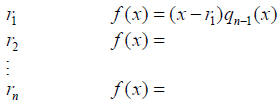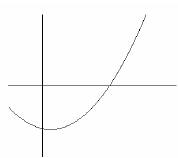Zeros of a Polynomial Function
L19 Zeros of a Polynomial Function
Division Algorithm for Polynomials
| If f and g are two polynomials and g is not the zero polynomial, then there are the unique polynomials q (quotient) and r (remainder) such that  where r(x) either the zero polynomial or of degree less than the degree of g(x). |
Note: If g(x) = x − c, then f (x) = q(x)(x − c) + r ,
where r is a number.
If x = c, then f (c) =
Remainder Theorem
| If a polynomial f (x) is divided by (x − c), then
the remainder r = f (c). |
Example: Find the remainder if f (x) = x4 − 6x3
+ 2 is
divided by (x + 2). Use
synthetic division
the Remainder Theorem
Example: Use the Remainder Theorem to find f (3) if
f (x) = x6 − 6x5 + 54x2 −16x +1
Note: If the polynomial f (x) is divided by (x − c) and
the remainder r = 0, then f (c) = 0, that is, c is a
zero of f (x).
Example: If f (x) = x3 − 6x + 4, is 2 a zero of f ?
| The polynomial (x − c) is a factor of the
polynomial f (x) if and only if f (c) = 0. |
Proof:
If (x − c) is a factor of f , then f (x) =
hence f (c) =
If f (c) = 0, then r = f (c) = and f (x) =
therefore (x − c) is a factor of f .
Example: Is (x −1) a factor of x3 − 2x +1?
Example: Factor f (x) into linear factors given that c is
a
zero of f (x).
f (x) = 3x3 − 5x2 −16x +12;
c = −2
Fundamental Theorem of Algebra
| Every polynomial of degree 1 or more has at least one complex zero . |
Let deg f (x) = n, n ≥1
Zeros:

Number of Zeros Theorem
| A polynomial of degree n has at most n distinct zeros. |
Note: A polynomial of degree n has exactly n complex
zeros if to count each zero as many times as its
multiplicity .
Conjugate Zeros Theorem
| If f (x) is a polynomial whose coefficients are
real , and if a + bi is a zero of f (x), with a and b real numbers, then a − bi is also a zero of f (x). |
Example: One zero is given, find all others


Example: Find the polynomial of degree 3 with real
coefficients that satisfies the conditions:
zeros @ −2,1, 0
f (−1) = −1
Example: Find a polynomial of the lowest degree
possible with only real coefficients which has the given
zeros:
−1
6 − 3i
Bounds of Zeros
Let M > 0.
A number M is called a bound on zeros of a polynomial f
if everyreal zero c lies between – M and M, inclusive,
that is,
−M ≤ c ≤ M
| Theorem: Let f denote a polynomial of degree n
whose leading coefficient is 1.  A bound M on the real zeros of f is the smallest of the two numbers:
|
Notes: 1) If the leading coefficient of the polynomial
f (x) is not 1, that is, an≠1 , in order to use the Theorem
you can replace f (x) with the polynomial 
since f ( x) has the same zeros as g(x).
2) The bounds on the zeros give a good choice of
Xmin and Xmax of the viewing rectangle since all the x- intercepts
of the graph can be seen .
Example: (a) Find bounds on the real zeros of the
polynomial function f ( x) = −3x3 + 8x2 − 6x + 9.
(b) Use a graphing utility to graph the polynomial in the
viewing rectangle determined by the bounds on the zeros.
Approximate the real zeros (x-intercepts).
Intermediate Value Theorem
| If f (x) is a polynomial with only real
coefficients and if for real numbers a and b, the values f (a) and f (b) are of opposite signs , then there exists at least one real zero between a and b. |

Example: Show that the polynomial has a real zero
between 2 and 3.
f (x) = 2x3 − 9x2 + x + 20
| Prev | Next |
